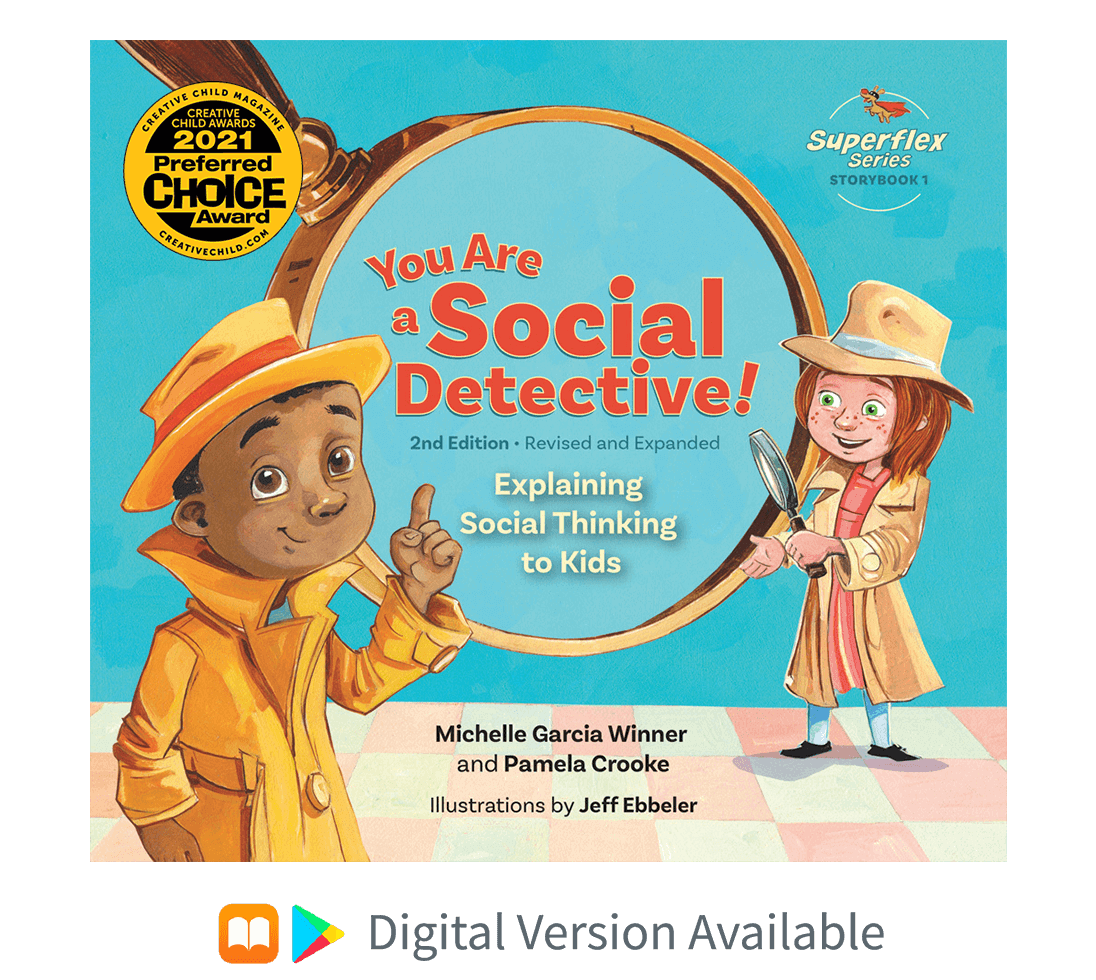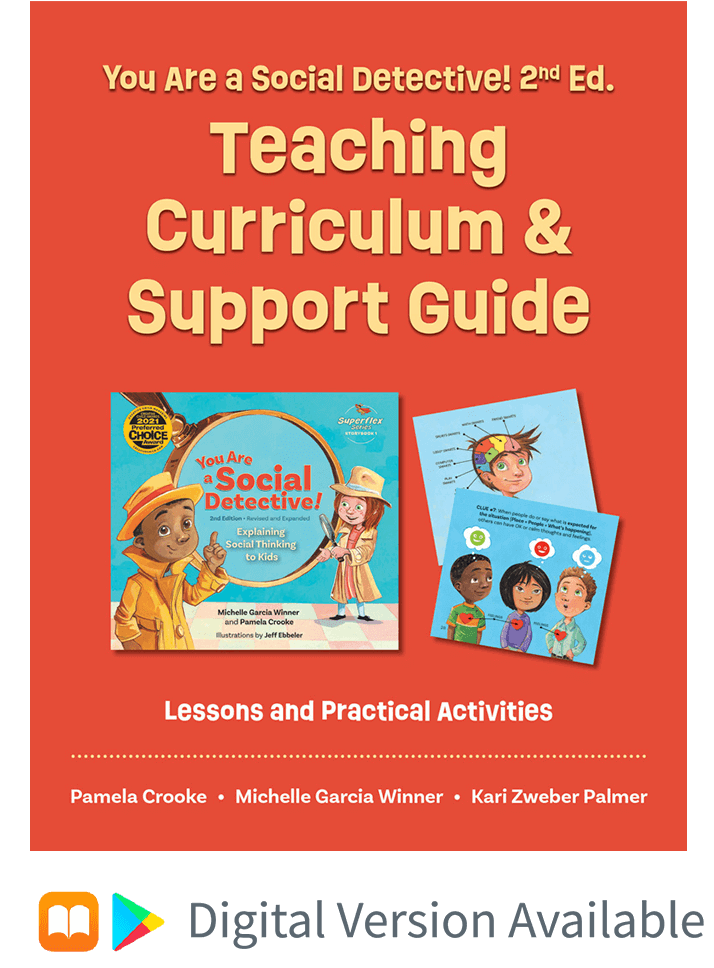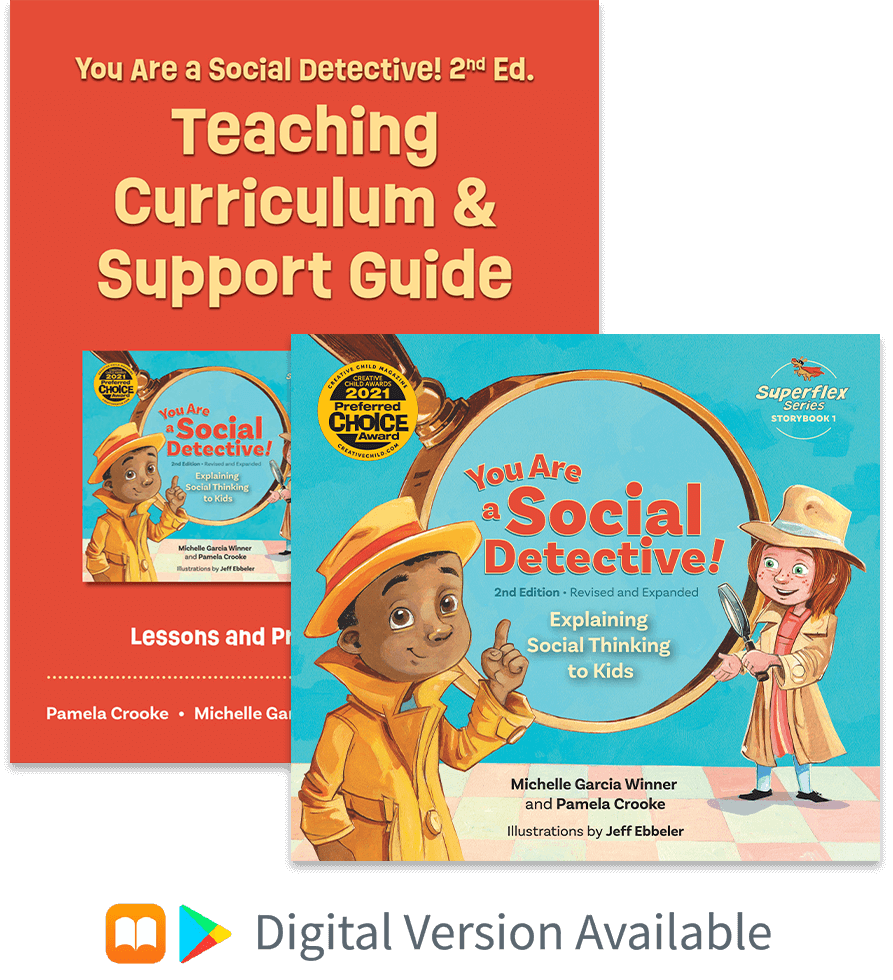
Part 1 of this two-part series explores
- The difference between social self-awareness and social self-regulation
- Strategies for preparing young children to use the Superflex Curriculum when they get older
- Ways to develop social detective thinking to figure out the plan of the group and the hidden expectations based on the situation
- Insight into how teaching Superflex aligns with academic standards
Part 2 of this two-part series you’ll explore many different social thinking strategies for navigating in the social world. Learn how to teach Superflex in the mainstream classroom, in-person, or online.
3.5 hours of training and CE credit available for select professionals. For any special accommodations or assistance with resources email us.
Browse additional Social Detective & Superflex resources related this online training course.
Part 1: Me in the Social World—It All Starts with Social Self-Awareness
Series Name: Social Detective, Superflex®, and Friends Take On Social Emotional Learning: Teaching the Concepts with Fidelity
Replay access through November 30, 2023
Detailed Description
Who should attend
This two-part series is filled with creative activities and strategies for use in the mainstream classroom, small groups, or individually to support reading comprehension, written expression, conflict resolution, and working as part of a group. We also discuss the connections between the Social Thinking® Methodology and social emotional learning (SEL) programs, positive behavioral interventions and supports (PBIS).
In Part 1: Me in the Social World—It All Starts with Social Self-Awareness of this two-part series, we begin our journey and dive into how to support students, clients, and patients in learning about themselves as part of the social world. We explore increasing self-awareness through learning about our brains and their smarts, developing our Social Detective thinking, and introducing the UnthinkaBots (formally Unthinkables), including:
- The difference between social self-awareness and social self-regulation
- The dos and don'ts of using Social Thinking® teaching materials
- Strategies for preparing young children to use the Superflex Curriculum when they get older
- How to teach children about their brain’s strengths and weaknesses
- Developing Social Detective thinking to figure out the plan of the group and the hidden rules and expectations
- How teaching Superflex aligns with academic standards
- Strategies and activity ideas from interventionists that can be used face to face or as part of distance learning
- The scope and sequence of our books You are a Social Detective and Superflex…A Superhero Social Thinking Curriculum for teaching elementary school students
Course Content Disclosure: This course focuses on the use of Social Thinking’s books You are a Social Detective! and Superflex…A Superhero Social Thinking Curriculum to teach social competencies. Our intention is NOT to market the products, but instead to demonstrate how to teach with fidelity and highlight scope, sequence, and pacing of the curricula in the manner for which they were designed.
Explore Part 2: Using Social Competencies to Navigate in the Social World of this series we continue our journey by exploring many different strategies, then put that knowledge and skill together to practice and learn more about navigating in the social world.
Who Should Attend
The Social Thinking Methodology is used by a wide variety of professionals; including speech-language pathologists, special and general education teachers, social workers, counselors, clinical and school psychologists, occupational therapists, behavior specialists, and school administrators to name a few. It’s also used by family members and caregivers across settings.
About this Series
Social Detective, Superflex®, and Friends Take On Social Emotional Learning: Teaching the Concepts with Fidelity
This two-part series is packed with strategies and activities to help your students, clients, and patients learn more about the social world and how to navigate to self-regulate within it. Social Detective thinking, Superflexible thinking, UnthinkaBots (formally Unthinkables), and Thinkables are our backdrop for this teaching.
Part 1: Me in the Social World—It All Starts with Social Self-Awareness
Part 2: Using Social Competencies to Navigate in the Social World
Throughout this series, we’ll break down the journey using practical and engaging strategies and activities. We always start by learning more about how the social world works before exploring how to work within it.
Series Content Disclosure: This course focuses on the use of Social Thinking’s books You are a Social Detective! and Superflex…A Superhero Social Thinking Curriculum to teach social competencies.
Our intention is NOT to market the products, but instead to demonstrate how to teach with fidelity and highlight scope, sequence, and pacing of the curricula in the manner for which they were designed.
Learning Objectives and Agenda
Objectives
Participants will be able to:
- Explain the connection between a) awareness of the situation and people, b) hidden expectations or unspoken rules, and c) behaviors that are considered expected or unexpected for the situation (where we are + what’s happening + who are the people).
- List two activities to increase self-awareness.
- Explain how teaching social observation, interpretation, social problem solving, and self-regulation are aligned with academic standards (e.g., speaking and listening, reading literature, and writing).
Agenda
- 1 hour and 20 minutes
- Explore how thinking socially is our "meaning maker" and how it ties to executive functioning, social attention, and cognitive flexibility
- Review foundational Social Thinking Vocabulary concepts and how to teach them through the book You are a Social Detective!
- 2 hours and 10 minutes
- Connect the teachings of You are a Social Detective! and the Superflex Curriculum to academic standards by exploring the social-academic connection
- Learn about emotional dysregulation and Superflex's teachings
- Previously Recorded Q & A Session
Continuing Education Credit
3.5 hours toward CE credit, if applicable
Click here to see if you can receive CE credit by Profession and by State
We are proud to provide access to continuing education credit for:
- Speech-Language Pathologists
- Educators
- ...and others!
Technical requirements to participate in online training
Streaming compatible browser
The best browser for streaming is Google Chrome. If you are unable to use Chrome, please make sure the version of your browser is the latest and greatest.
Download ChromeHigh-speed internet connection
Make sure you are accessing the online course on a device that is connected to high speed internet—that means your download speed is at least 25Mbps.
Run Internet Speed TestOpen firewall ports
If you are accessing the online course from your school or organization, ask your network administrator if there are any firewall ports that need to be opened.
Learn More











